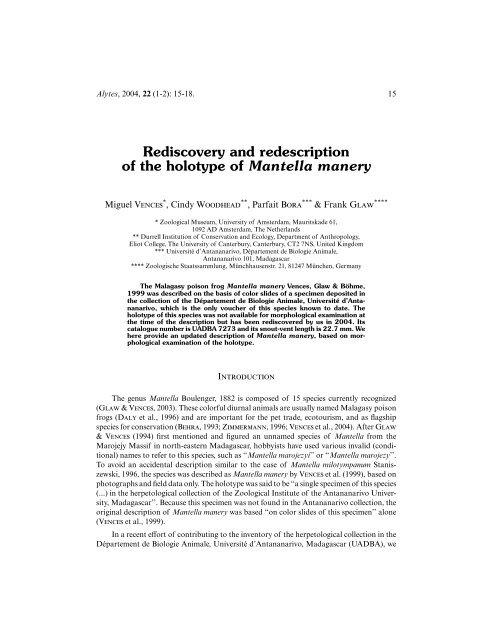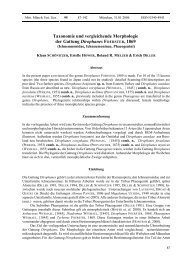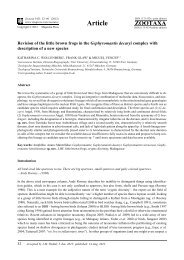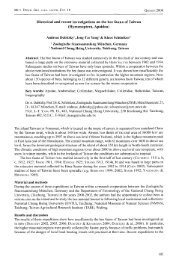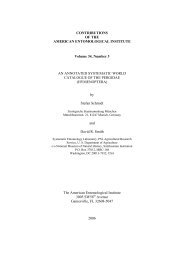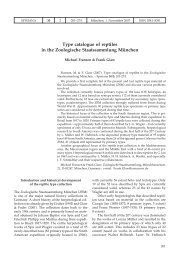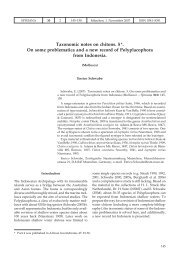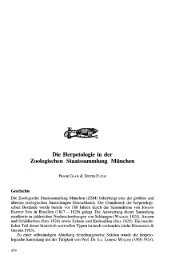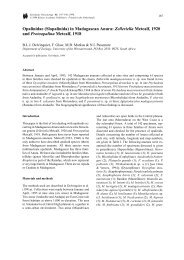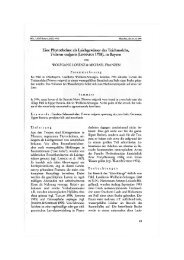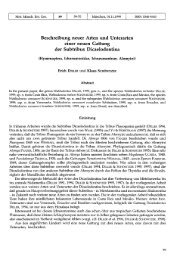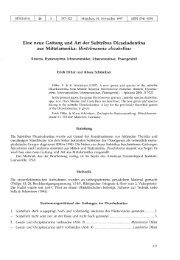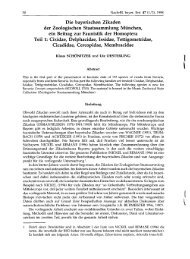Vences et al. - Zoologische Staatssammlung München
Vences et al. - Zoologische Staatssammlung München
Vences et al. - Zoologische Staatssammlung München
- No tags were found...
Create successful ePaper yourself
Turn your PDF publications into a flip-book with our unique Google optimized e-Paper software.
16 ALYTES 22 (1-2)rediscovered the holotype of Mantella manery in February 2004. In the following we providea redescription of this species and focus on the previously unavailable morphologic<strong>al</strong> featuresof the holotype. Terminology follows <strong>Vences</strong> <strong>et</strong> <strong>al</strong>. (1999).Mantella manery <strong>Vences</strong>, Glaw & Böhme, 1999Mantella manery <strong>Vences</strong>, Glaw & Böhme, 1999. ¢ Name-bearing type: holotype by origin<strong>al</strong> designation(<strong>Vences</strong> <strong>et</strong> <strong>al</strong>. 1999: 15), its cat<strong>al</strong>ogue number here first reported as UADBA 7273.Usage of the name subsequent to the origin<strong>al</strong> description:Mantella manery: <strong>Vences</strong> <strong>et</strong> <strong>al</strong>., 1999; Glaw &<strong>Vences</strong>, 2000, 2003; Schaefer <strong>et</strong> <strong>al</strong>., 2002;<strong>Vences</strong> &Glaw, 2003.Mantella manery n. sp. (1999): Staniszewski, 2001.Morphology of holotype. ¢ Adult specimen in moderate state of preservation. Sever<strong>al</strong> cutsthrough ventr<strong>al</strong> skin for gonad examination. Some tissue removed from left femur for DNAextraction. Probably a m<strong>al</strong>e, but gonads not sufficiently recognizable due to poor preservationand dark color of inner organs. Body relatively stout for a Mantella; head clearly longer thanwide, slighly narrower than body; snout rounded in dors<strong>al</strong> and later<strong>al</strong> views; nostrils directedlater<strong>al</strong>ly, very slightly protuberant; canthus rostr<strong>al</strong>is distinct, concave; lore<strong>al</strong> region slightlyconcave; tympanum distinct, rounded, its diam<strong>et</strong>er 57 % of eye diam<strong>et</strong>er; supratympanic folddistinct, slightly curved; tongue narrow and longish-ovoid, very slightly notched posteriorly;vomerine and maxillary te<strong>et</strong>h absent. Forelimbs slender; subarticular tubercles single; innerand outer m<strong>et</strong>acarp<strong>al</strong> tubercles distinct; fingers without webbing; comparative finger length 1
18 ALYTES 22 (1-2)<strong>Vences</strong>, M., Chiari, Y., Raharivololoniaina, L. &Meyer, A., 2004. ¢ High mitochondri<strong>al</strong> diversitywithin and among populations of M<strong>al</strong>agasy poison frogs. Mol. Phylogen<strong>et</strong>. Evol., 30: 295-307.<strong>Vences</strong>, M. &Glaw, F., 2003. ¢ Mantella. In: S. M. Goodman &J. P. Benstead (ed.), The Natur<strong>al</strong>History of Madagascar, Chicago & London, The University of Chicago Press: 913-916.<strong>Vences</strong>, M., Glaw, F. &Böhme, W., 1999. ¢ A review of the genus Mantella (Anura, Ranidae,Mantellinae): taxonomy, distribution and conservation of M<strong>al</strong>agasy poison frogs. Alytes, 17: 3-72.Zimmermann, H., 1996. ¢ Der Schutz des tropischen Regenw<strong>al</strong>des und ein kleines Fröschchen inOst-Madagaskar. Stapfia, 47: 189-218.Corresponding editor: Alain Dubois.© ISSCA 2004


